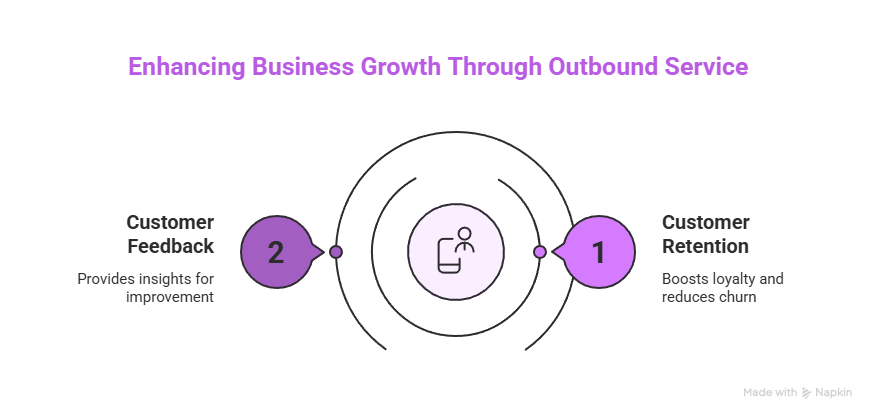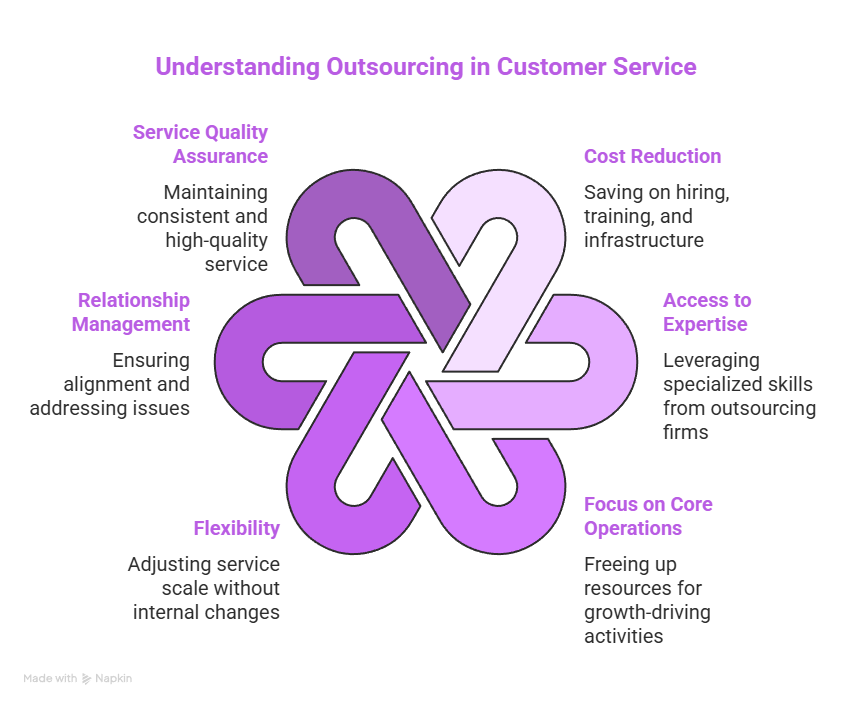Outbound Customer Service
30 Jan 2024 By: Michael Kansky
Updated
Outbound customer service plays a key role in managing customer relationships by actively reaching out to them. Instead of waiting for customers to make the first move, companies take the initiative. The goal? To boost customer happiness, keep them coming back, and build loyalty. This approach includes a range of activities like sales calls, satisfaction surveys, and sharing product details.

Outbound customer service, where the company reaches out first. It stands in contrast to inbound customer service, which starts with the customer reaching out. Though both types are crucial, outbound service offers special perks like tackling customer problems early on, collecting insightful feedback, and forging deeper connections with customers. We’ll dive deep into outbound customer service. Exploring its significance and how outsourcing companies usually put it into action.
Transform customer satisfaction – discover the power of Inbound Customer Service today!
Definition and Key Concepts
Outbound customer service involves the company reaching out to its customers first. Covering a variety of actions like sales calls, marketing efforts, satisfaction surveys, and follow-ups post-purchase. Its primary aim is to improve the customer experience, foster loyalty, and drive the company’s growth.
Key concepts in outbound customer service includes ‘customer touchpoints’. The different ways a company interacts with its customers, initiated by the company itself. This includes through calls, emails, and texts. Another important idea is ‘customer journey mapping’. This means analyzing the customer’s experience from their viewpoint to spot chances for proactive service.
Elevate your business with strategic Customer Acquisition!
Proactive vs Reactive Customer Service
Outbound customer service is a proactive approach. It means the company contacts the customer first, not the other way around. This approach helps prevent issues, increases satisfaction, and strengthens customer bonds. For example, a company might call to check in after a purchase. Or, it could inform customers about new offerings.
In contrast, inbound customer service is reactive. It’s about answering customer queries or resolving complaints. Though crucial for fixing problems and keeping customers content, it’s a response to issues that have already occurred. Therefore, blending proactive (outbound) and reactive (inbound) customer service often works best.
Importance of Outbound Customer Service

Outbound customer service is crucial for customer relationships. It helps companies reach out first, boosting satisfaction and retention. This boosts business growth. Here’s why it matters:
Customer Retention
Outbound customer service boosts customer retention. When companies reach out first, it shows they value and prioritize customer needs. This builds loyalty and encourages customers to return. Proactive service also prevents dissatisfaction and reduces the chance of customers leaving for competitors.
Retaining customers is usually cheaper than finding new ones. A Bain & Company study found that improving retention by 5% could boost profits by 25% to 95%. So, excellent customer service plays a critical role in improving a company’s financial health.
Customer Feedback
Outbound customer service lets companies collect crucial customer feedback. Through satisfaction surveys or follow-up calls, insights into what customers need and prefer are uncovered. This information helps enhance products and services, create new ones, and shape marketing strategies.
Feedback is essential for better understanding of customer preferences, likes, dislikes, and desired improvements. By actively seeking it via outbound efforts, companies can anticipate customer needs and continuously refine their offerings.
Trending Now
An article from Forbes highlights that personalized service is not just a trend in today’s customer service landscape. It’s a necessity. A survey by McKinsey shows that a whopping 70% of customers expect interactions tailored specifically to them. Moreover, research from Twilio backs this up. Stating that 60% of customers are more likely to stick with a brand after experiencing a purchase that feels personal to them. Yet, this isn’t just about knowing your customers’ names. They’re looking for a deeper, more emotional bond with brands that truly get their unique needs and preferences.
Implementation of Outbound Customer Service

Setting up outbound customer service requires several steps. Starting with strategy and moving to execution and review. Here’s a brief outline:
First, a company must craft a strategy. This means setting goals for outbound efforts. Then, pinpointing the target audience. Choosing communication channels (like phone, email, or social media). And then deciding on the main message. The strategy should also cover how to collect and analyze feedback from customers.
Planning and Strategy Development
The initial phase of rolling out outbound customer service is planning and crafting a strategy. This step sets the aims of the outreach. It pinpoints who will be targeted and selects channels (like phone, email, or social media) and the main messages. Additionally, it should lay out a method for collecting and analyzing feedback from customers.
After setting the strategy, the next move is to prepare an execution plan. This plan lists needs, like staff and technology. It sets a timetable for outreach. And, it outlines how to handle customer reactions and feedback.
Execution
The execution phase is about putting the outbound customer service plan into action. This means making sales calls, carrying out satisfaction surveys, marketing emails, or even using an outreach Chrome extension to streamline communication efforts. It’s crucial to keep an eye on how things are going and to collect customer feedback to measure success.
A vital part of this phase is to ensure all activities are done professionally and with a customer-first approach. This means being polite, listening to what customers have to say, and providing accurate, useful information. Moreover, it’s important to follow laws and regulations. Especially those concerning privacy and data protection.
Evaluation
The last step in rolling out outbound customer service is evaluation. This step requires looking at the outcomes of the service activities. Then, checking how well they met the strategy’s goals. And then pinpointing areas that need enhancement. Evaluation methods can include reviewing customer feedback, monitoring key performance indicators (KPIs), and performing internal audits.
Evaluation is crucial because it lets a company gauge how effective its outbound efforts are. It lets you know where adjustments are needed. Through ongoing evaluation and refinement, a company can steadily enhance its customer service. Ultimately, achieving superior outcomes.
Unlock success by mastering your KPIs – explore now!
Challenges in Outbound Customer Service

Outbound customer service offers numerous advantages but also faces several hurdles. These include balancing proactive and reactive approaches. Reaching customers in a busy communication landscape. And adhering to legal and regulatory requirements.
A significant challenge is finding the right mix of proactive and reactive customer service. Proactive efforts can prevent problems and enhance satisfaction. But, it might be perceived as intrusive if not handled well. Thus, it’s crucial to thoughtfully plan and carry out outbound activities. Ensuring they’re welcomed by customers and genuinely beneficial.
Reaching Customers
Reaching customers in today’s crowded communication landscape is tough. The vast number of channels and the flood of marketing messages make it hard to capture customers’ attention. It’s important to pick the right channels and create messages that truly speak to your audience.
To break through the noise, segmentation and personalization are essential. By grouping customers based on their preferences and characteristics, companies can tailor their messages. This strategy increases the impact of outbound efforts and enhances customer satisfaction.
Compliance with Laws and Regulations
Outbound customer service must also navigate legal compliance. This covers privacy, data protection, telemarketing, and email marketing laws. Ignoring these can lead to legal issues and harm the company’s reputation.
To stay compliant, companies need a solid grasp of applicable laws and regulations. They must secure customer permissions, keep precise records, and frequently update their compliance practices.
Outsourcing Outbound Customer Service

Many businesses opt to outsource their outbound customer service to business process outsourcing (BPO) companies. This approach offers benefits like cost reduction, access to expert knowledge, and more time to focus on core operations. Yet, outsourcing comes with its own set of challenges. Such as overseeing the partnership and ensuring service quality.
When choosing to outsource, picking the right service provider and crafting a thorough agreement is crucial. This contract should outline the services to be delivered and performance metrics. Plus, customer data management practices and how the relationship will be monitored and managed.
Benefits of Outsourcing
Outsourcing outbound customer service offers several advantages. First, it can save money. Companies save on hiring, training, and infrastructure costs by outsourcing. Second, it grants access to specialized skills. Outsourcing firms bring deep customer service expertise. Ensuring quality support for both the company and its customers.
Third, it lets companies concentrate on their main operations. Outsourcing frees up resources, allowing businesses to focus on growth-driving activities. Lastly, it adds flexibility. Companies can adjust the scale of their customer service efforts without handling staffing or infrastructure changes in-house.
Challenges of Outsourcing
Outsourcing comes with its set of challenges, despite its benefits. Managing the outsourcing relationship is a key issue. This means making sure the service provider fully grasps the company’s specific needs and meets them as expected. It also requires keeping an eye on the provider’s performance and tackling any problems that pop up.
Ensuring the quality of outsourced services is another hurdle. Even with a provider’s expertise in customer service, service quality can vary. This variation depends on the agents’ skills, the provider’s processes and systems, and the company’s oversight. Setting clear goals and KPIs. Also, consistently reviewing the provider’s performance is essential. These are steps to maintain quality of service.
Conclusion
Outbound customer service is an integral component of any thriving call center, relying on a combination of technology, strategy, and skilled agents to deliver exceptional service and drive business success. By leveraging the right tools and adopting a customer-centric approach. Companies can effectively manage outbound communication and enhance the overall customer experience.
“The key is when a customer walks away, thinking, ‘Wow, I love doing business with them, and I want to tell others about the experience.'”
– Shep Hyken
Many businesses opt to outsource their outbound customer service. Outsourcing offers cost efficiency, specialized skills, and operational flexibility. Whether managed internally or outsourced, it’s crucial to strategize and oversee outbound customer service carefully. Ready to take on this challenge? Our virtual assistants and 24/7 customer service team are at your service to manage your back-office tasks and customer support. This frees up your time to concentrate on what’s truly important. Starting at just $8.50 per hour, our bilingual agents are ready to elevate your efficiency. Start your trial today and experience the difference with HelpSquad BPO.


